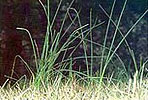 Plantain is a perennial. It grows in a basal rosette with broad oval leaves. Its roots are fibrous with a strong taproot. Its leaves are smooth or slightly hairy, oval to elliptic, with a waxy surface and veins that are parallel to the margins. Margins are untoothed and sometimes wavy. Flowers produced on unbranched stalks (scapes) that arise from the rosette. Flowering stems are 5-15 inches long, clustered with small flowers that have whitish petals and bracts surrounding the flowers. Plantain is a perennial. It grows in a basal rosette with broad oval leaves. Its roots are fibrous with a strong taproot. Its leaves are smooth or slightly hairy, oval to elliptic, with a waxy surface and veins that are parallel to the margins. Margins are untoothed and sometimes wavy. Flowers produced on unbranched stalks (scapes) that arise from the rosette. Flowering stems are 5-15 inches long, clustered with small flowers that have whitish petals and bracts surrounding the flowers. |
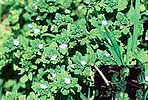 Speedwell is a winter annual that germinates in mid-fall. Speedwells have a short tap root to fibrous root systems and branching upright stems. The lower leaves are near round with toothed margins. The upper leaves are more pointed. The plant is covered with fine hairs. Corn Speedwell flowers are small and white to blue in color. The flowers are found in the leaf axis and the seed develops into a distinctive heart shape. Speedwell is a winter annual that germinates in mid-fall. Speedwells have a short tap root to fibrous root systems and branching upright stems. The lower leaves are near round with toothed margins. The upper leaves are more pointed. The plant is covered with fine hairs. Corn Speedwell flowers are small and white to blue in color. The flowers are found in the leaf axis and the seed develops into a distinctive heart shape. |
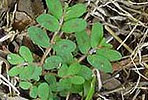 Spotted spurge is a summer annual. While similar to prostate spurge, there are several subtle differences in the two varieties. Spotted spurge has a more erect growth habit than prostrate spurge. Its leaves are small and oblong shaped with an irregular red to purple spot in the center. The leaves that grow opposite on the stem. Spurge contains a milky sap in the stem. The flower of spotted spurge is small and green in color. It germinates in mid spring and flowers from June to September. Spotted spurge is a summer annual. While similar to prostate spurge, there are several subtle differences in the two varieties. Spotted spurge has a more erect growth habit than prostrate spurge. Its leaves are small and oblong shaped with an irregular red to purple spot in the center. The leaves that grow opposite on the stem. Spurge contains a milky sap in the stem. The flower of spotted spurge is small and green in color. It germinates in mid spring and flowers from June to September. |
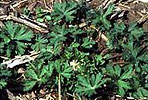 Wild geranium, also called Carolina geranium, is a semi-erect winter annual. The erect stems are branching and covered with hair. The alternate leaves are on long petioles and are divided into segmented leaflets which are blunt toothed. The flowers have 5 white to pink petals and form in clusters. The seed forms in a fruit capsule that forms a “storks bill”. Wild geranium, also called Carolina geranium, is a semi-erect winter annual. The erect stems are branching and covered with hair. The alternate leaves are on long petioles and are divided into segmented leaflets which are blunt toothed. The flowers have 5 white to pink petals and form in clusters. The seed forms in a fruit capsule that forms a “storks bill”. |
 Wild onion and wild garlic are both winter perennials. The leaves are waxy, upright and needle shaped growing 8-12 inches long. The leaves of wild garlic are hollow and round and have a strong odor. The leaves of wild onion are solid and flat and appear directly from the bulb. Both plants grow from underground bulbs. The membrane-coated bulbs of wild garlic are flattened on one side and have bulblets. Wild onion bulbs are white inside with a strong odor and are covered with a fibrous, scaly coat. The white to light green flowers of wild garlic develop on short stems above aerial bulbs.Wild onion does not have a stem; white to pink flowers with six elliptical segments. Both wild onion and wild garlic spread by bulbs, seed and bulblets. Both plants flower from April through June. Wild onion and wild garlic are both winter perennials. The leaves are waxy, upright and needle shaped growing 8-12 inches long. The leaves of wild garlic are hollow and round and have a strong odor. The leaves of wild onion are solid and flat and appear directly from the bulb. Both plants grow from underground bulbs. The membrane-coated bulbs of wild garlic are flattened on one side and have bulblets. Wild onion bulbs are white inside with a strong odor and are covered with a fibrous, scaly coat. The white to light green flowers of wild garlic develop on short stems above aerial bulbs.Wild onion does not have a stem; white to pink flowers with six elliptical segments. Both wild onion and wild garlic spread by bulbs, seed and bulblets. Both plants flower from April through June. |
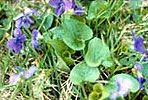 Wild violet is a winter perennial, growing 2 – 5 inches tall. It can have a tap root or a fibrous root system, and also can produce rooting stolons and rhizomes. The leaves can vary but usually are heart shaped, on long petioles with scalloped to shallow rounded margins. The flowers of wild violet range from white to blue to purple and appear from March to June. Wild violet flowers are pansy-like with three lower petals and two lateral petals on long single flower stalks. Crabgrass is a summer annual that germinates when soil temperatures reach a consistent 55 degrees F and is generally killed at the first frost. Wild violet is a winter perennial, growing 2 – 5 inches tall. It can have a tap root or a fibrous root system, and also can produce rooting stolons and rhizomes. The leaves can vary but usually are heart shaped, on long petioles with scalloped to shallow rounded margins. The flowers of wild violet range from white to blue to purple and appear from March to June. Wild violet flowers are pansy-like with three lower petals and two lateral petals on long single flower stalks. Crabgrass is a summer annual that germinates when soil temperatures reach a consistent 55 degrees F and is generally killed at the first frost. |
 Crabgrass leaves are rolled in the bud; the first leaf appears short, wide and blunt-tipped. The ligule is tall and membranous with jagged edges, and the auricles are absent. The collar is broad with long hairs. Crabgrass is light green in color, coarse bladed and will root at the nodes when they touch the ground. A single crabgrass plant can produce up to 700 tillers. It is a bunch type grass. The inflorescence is a panicle of branches, with spikelets in two rows. A crabgrass plant can produce 150,000 seeds. Crabgrass needs warm soils and sunlight to germinate. Crabgrass leaves are rolled in the bud; the first leaf appears short, wide and blunt-tipped. The ligule is tall and membranous with jagged edges, and the auricles are absent. The collar is broad with long hairs. Crabgrass is light green in color, coarse bladed and will root at the nodes when they touch the ground. A single crabgrass plant can produce up to 700 tillers. It is a bunch type grass. The inflorescence is a panicle of branches, with spikelets in two rows. A crabgrass plant can produce 150,000 seeds. Crabgrass needs warm soils and sunlight to germinate. |
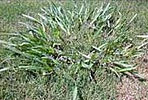 Dallisgrass is a warm season coarse perennial which is light green in color. The leaves are rolled in the bud, flat and wide (1/2″). Auricles are absent and the ligule is tall, pointed, and membranous. Dallisgrass has hairs on the lower portion of the leaf near the ligule. The seedhead contains 3 – 6 spikes, with seeds on both sides of the spike. Dallisgrass can from short thick rhizomes, but spreads upright in clumps. This highly invasive plant germinates in soil temperatures of 60 to 65 degrees F and thrives in the hot humid conditions of the southern states. Dallisgrass is a warm season coarse perennial which is light green in color. The leaves are rolled in the bud, flat and wide (1/2″). Auricles are absent and the ligule is tall, pointed, and membranous. Dallisgrass has hairs on the lower portion of the leaf near the ligule. The seedhead contains 3 – 6 spikes, with seeds on both sides of the spike. Dallisgrass can from short thick rhizomes, but spreads upright in clumps. This highly invasive plant germinates in soil temperatures of 60 to 65 degrees F and thrives in the hot humid conditions of the southern states. |
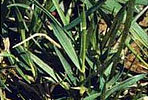 Tall Fescue is a deep rooted, cool season perennial grass. Tall fescue does produce short rhizomes but has a bunch-type growth habit – it spreads primarily by erect tillers. Leaf blades are glossy on the underside and serrated on the margins. Tall Fescue is a deep rooted, cool season perennial grass. Tall fescue does produce short rhizomes but has a bunch-type growth habit – it spreads primarily by erect tillers. Leaf blades are glossy on the underside and serrated on the margins. |
<Back to Main Weed Management Page